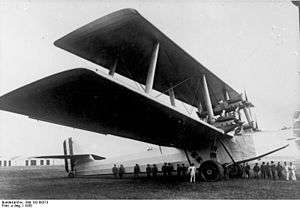Caproni Ca.90
| Caproni Ca 90 | |
|---|---|
 | |
| Role | Heavy bomber |
| National origin | Italy |
| Manufacturer | Caproni |
| First flight | 1929 |
| Number built | 1 |
|
| |
The Caproni Ca.90 was a prototype Italian heavy bomber designed and built by Caproni. When it first flew in 1929 it was the largest aircraft in the world.[1]
Design and development
A six-engined inverted sesquiplane the Caproni Ca.90 was designed as a heavy bomber and first flew in 1929.[1] It had two tandem pairs of 1,000 hp (746 kW) Isotta-Fraschini Asso 1000 W-18 inline piston engines mounted above the lower wing, each pair drove a four-bladed pusher and a two-bladed tractor propeller.[1] Another pair of engines was mounted above the fuselage.[1] Only one Ca.90 was built.[1]
Although the Dornier Do X flying boat that flew later in 1929 had a larger wingspan and weight it remained the largest landplane until the arrival of the Tupolev ANT-20 in 1934.[1]
Specifications

Data from [1]Illustrated Encyclopedia of Aircraft
General characteristics
- Length: 26.95 m (88 ft 5 in)
- Upper wingspan: 34.90 m (114 ft 6 in)
- Lower wingspan: 46.60 m (152 ft 11 in)
- Height: 10.80 m (35 ft 5 in)
- Wing area: 496.60 m2 (5,345.4 sq ft)
- Empty weight: 15,000 kg (33,069 lb)
- Max takeoff weight: 30,000 kg (66,139 lb)
- Powerplant: 6 × Isotta-Fraschini Asso 1000 W-18 water-cooled inline piston engines, 750 kW (1,000 hp) each
Performance
- Maximum speed: 205 km/h (127 mph; 111 kn)
- Range: 1,290 km (802 mi; 697 nmi)
- Endurance: 7 hours
- Service ceiling: 4,500 m (14,764 ft)
Armament
- Guns: defensive machine-guns
- Bombs: 8000kg
References
- Notes
- Bibliography
- Angelucci, Enzo. The Rand McNally Encyclopedia of Military Aircraft, 1914-1980. San Diego, California: The Military Press, 1983. ISBN 0-517-41021-4.
- The Illustrated Encyclopedia of Aircraft (Part Work 1982-1985). London: Orbis Publishing, 1985.
External links
| Wikimedia Commons has media related to Caproni Ca.90. |
